 |
 |
|
 |
State DOTs to mark 50th anniversary of the interstate highway system |
 |
 |
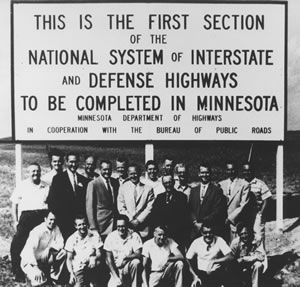 |
Inspectors, designers and engineers who worked on the first section of the interstate highway system in Minnesota (I-35 near Owatonna) gather in Rochester in 1958 to celebrate its completion. Photo archive |
June 29, 2006 marks the 50th anniversary of the signing of the Federal Highway Act of 1956 by President Dwight D. Eisenhower. This legislation provided initial funding for construction of the National System of Interstate and Defense Highways.
“Mn/DOT is joining with other state DOTs and the American Association of State Highway and Transportation Officials in commemorating the anniversary of this landmark legislation and our nation’s greatest public works project,” said Lt. Gov./Commissioner Carol Molnau.
“The goal is to educate and inform the public about the interstate highway system, which is responsible for improving mobility, highway safety, quality of life and commerce in the United States.”
Nationally, AASHTO will be working with the states, the transportation industry and travel and tourism groups to plan a series of national events including reenacting the 1919 cross-country military convoy from San Francisco to Washington, D.C. Several sources, including AASHTO, cite the convoy as the seed that planted the idea of an interstate highway system in the mind of President Eisenhower.
More information on the convoy and other national events can be found at www.interstate50th.org, a Web-based clearinghouse of interstate events and information.
Molnau said that Mn/DOT is also partnering with state transportation interests like Tourism, Economic Development and Public Safety, as well as the Associated General Contractors, Minnesota Trucking Association and AAA. She said this “50th Anniversary Advisory Group” underscores the fact that the interstate highway system is about transportation and more.
“In addition to engaging transportation interests, we will tap into resources like Mn/DOT retirees, Area Transportation Partnerships, communities through which interstates pass, state and local chambers of commerce and historical societies,” she said. “The objective is to raise some of the policy questions that Minnesota and the rest of the nation face as we look to the next 50 years in transportation.”
By Jeanne Aamodt
In search of highway projects, anecdotes, oral histories
Mn/DOT has a Web site in progress, www.dot.state.mn.us/interstate50, which will feature a Minnesota “interstate project of the month.” The project for January is the first section of the national interstate system to be constructed in Minnesota, Interstate 35 near Owatonna (see historic photo in above article). The Office of Communications is looking for additional projects, as well as anecdotes and oral histories from current and retired Mn/DOT employees, to feature during 2006. Please contact Craig Wilkins at craig.wilkins@dot.state.mn.us or Lisa Yang in Communications at lisa.yang@dot.state.mn.us if you have stories to share.
|
|
back

|
 |
FIRST routes expanded on Twin Cities freeways |
 |
 |
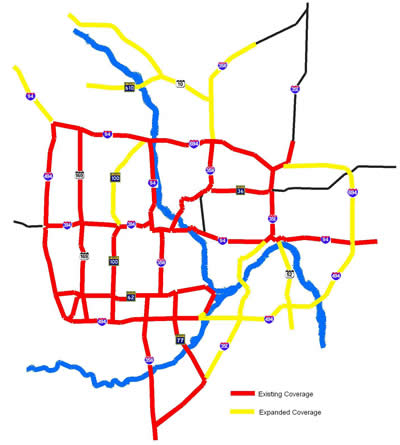 |
|
The number of Freeway Incident Response Safety Teams on Twin Cities metro area freeways were expanded Dec. 12. The new routes, shown in yellow, will provide coverage of about 70 additional miles per day. |
Mn/DOT increased its freeway incident management efforts Dec. 12 by expanding the number of Freeway Incident Response Safety Teams on Twin Cities metro area freeways.
FIRST consists of Mn/DOT employees who patrol Twin Cities freeways in specially equipped pickup trucks to respond to roadway incidents that cause congestion and, often, secondary crashes.
Prior to this expansion, FIRST trucks patrolled about 170 miles of Twin Cities freeway each day with up to eight routes. With the expansion, the FIRST program added two more routes to cover up to 240 miles of freeway a day. The expanded FIRST truck routes will cover almost all Twin Cities area freeways inside and including the Interstate 494/I-694 ring.
Much of the new coverage is in the eastern and northern parts of the Twin Cities area.
“The FIRST trucks are busy,” said Brian Kary, an incident management engineer at Mn/DOT’s Regional Transportation Management Center in Roseville.
“They respond to more than 17,000 incidents a year. Their efforts help keep traffic moving on the Twin Cities metro roadways by clearing stalled vehicles and debris from the roads. And, they prevent secondary crashes that the vehicles and debris might otherwise cause.”
Mn/DOT’s RTMC manages the FIRST program and is home to the State Patrol Dispatch, the Mn/DOT maintenance dispatch and the traffic operations center. When traffic operations observers spot an incident, RTMC directs the closest FIRST vehicle to the situation. FIRST trucks assist the State Patrol with traffic control and scene security. They also help stalled motorists with tire changes, emergency fuel and minor repairs that allow the drivers to get their vehicles off the freeway.
The FIRST program received $300,000 from Mn/DOT’s Highway Systems Operation Plan to expand the service to this new level, Kary said. The program operates on a $1.3 million annual budget, which pays for staff, trucks and other equipment. The benefit to the public is less roadway delay, reduced fuel consumption, fewer secondary crashes and reduced emissions.
By Kevin Gutknecht
Reserve police officer gets FIRST-hand experience with safety service
Excerpt from an e-mail sent to Bernie Arseneau, state traffic engineer:
As a veteran reserve police officer, I have requested FIRST many times for motorists-in-need. I have observed your units countless times as they have provided their vital service on metro roadways. On Dec. 21, 2005, at approximately 17:30 hours, I made my first personal request for assistance to FIRST.
I had experienced a blow out while driving southbound in my personal vehicle on Hwy 100, just north of the Hwy 62 westbound exit. I managed to limp the car across traffic and park on the right road apron in 10 inches of deep, packed snow, as no shoulder exists in that area. Unfortunately, the spot that I had chosen as being adequately flat to safely change the driver's side tire left less than three feet between my car and the traffic lane.
Changing a tire in such a location during evening rush hour, especially at this time of year left me rightly concerned for my own safety. I placed flares along the edge of the road, well behind my car and prepared to change the tire. While placing flares, distracted drivers nearly caused three accidents, raising my concerns for my safety. I decided to call FIRST and request a unit to sit behind my car and provide a bit of visual and physical safety…
By the time that I had removed my spare tire from the trunk, a familiar OSHO-green truck pulled up on the road side behind me, its warning lights already alerting passing drivers. The operator exited his vehicle to speak to me and assess the situation...
He quickly grabbed his floor jack and portable impact wrench and went to work, despite my repeated claims that I could do it myself. Like a seasoned pit crew professional, he changed the tire in only a few minutes...Seconds later, I was back on the road, thanks to FIRST and this caring, professional public servant….
As I drove away, I realized that I had forgotten to ask his name….I'm not overstating it one bit to say that his presence very likely saved me from being hit or killed by a passing car. I've always been a firm supporter of the Highway Helper/FIRST program. Being on the receiving end of your department's service has given me new appreciation of the vital work that your staff perform every day. Thank you.
Warm Regards, Res. Sgt. Patrick Hart, Mound Police Department
|
|
back

|
 |
Innovation and Best Practices Program aims to make Mn/DOT work better |
 |
 |
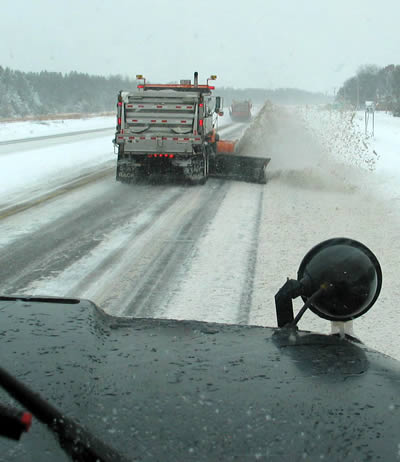 |
|
A snowplow operator assigned to the Baxter truck station uses a rear-mounted wing plow while working in tandem with another operator to clear a highway in District 3. Photo by Jenny Seelen
|
Dick Stehr, Engineering Services Division director, knew there was no shortage of good ideas in Mn/DOT. Mn/DOT employees, he says, are constantly looking for ways to be more efficient and effective in their jobs.
But sometimes a good idea becomes practice in only one district or office while other areas keep doing things they way they’ve always done them—not out of resistance to change, but because they don’t know there might be a better way.
The Innovation and Best Practices Program aims to remedy that by providing a formal way for employees to suggest best practices or innovations and for these to be studied for agency-wide implementation.
“I had a nagging thought that we don’t have a good opportunity for people to suggest new ideas, no way for new ideas to get to top management for review and implementation on a wider basis,” said Stehr.
Stehr and Bob Winter, District Operations Division director, met with district engineers and confirmed that there was no consistent way of communicating about new innovations or tracking implementation of changes in the way we work. They worked with Mark Larson, Measurement and Systems, to develop a formal way to submit, review and track best practices.
The first request for ideas netted 35 responses.
Among them was one from Bruce Yankowiak, District 1 land surveyor.
"The District Surveys office staff was spending precious production time providing land corner information to private and government surveyors along with the general public," said Yankowiak. "This information was also needed by the district for projects involving the purchase of new right of way. Some of the older land corner information was buried away in old survey field books, some dating back to the 1920's, which added to the retrieval time.
"I thought it would be great if we could get this information into some kind of data base that surveyors could search. It would save us time and it would give the customer a faster response time by giving them direct access to these documents," Yankowiak said.
"The data base did not materialize, but the newly developed Electronic Document Management System was going into operation. Old field notes and 'Certificate of Location of Government Corner' forms were scanned and indexed using spreadsheets with hyperlinks. All the documents were then imported into EDMS with the hyperlinks intact,” he said.
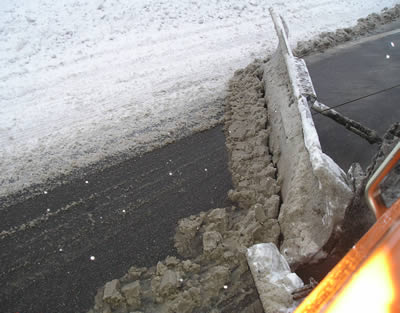 |
A close-up view of the rear-mounted wing plow. Photo by Jenny Seelen
|
The next goal is make the survey data available for public access through the external EDMS Web site.
"This has the potential to save up to ten hours a week in answering phone calls, making copies, etc," said Yankowiak.
Yankowiak submitted the idea and the proposal was selected for further review and development at the department level, which means it could be adapted as an agency standard or best practice.
For an idea to be adapted as a department best practice it must be something that could apply to more than one office or district, Stehr said.
“Not everything will become a mandatory practice everywhere – some may be good alternatives to consider for specific locations or offices,” he said.
For example, District 3’s Gary Niemi, area maintenance engineer, Baxter, proposed an idea to use rear-mounted wings on snowplows. The plows have been working in District 3 and increase efficiency by eliminating the need for plow drivers to make a final round to clear the windrows of snow left by the underbody plows.
“Will it work everywhere? We won’t know until we assess its application,” Stehr said.
The window on new ideas never closes, he added.
For more information on the Best Practices program, including how to submit your own idea, go to ihub/bestpractices.
By Kay Korsgaard
|
back

|
 |
Initiative, commitment spur improvements in winter maintenance operations |
 |
 |
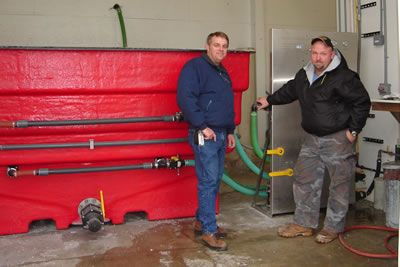 |
|
Brian Wolfgram (at left) and Bob Langanki are shown with District 6’s new automated chemical mixing system. Photo by Kristine Hernandez
|
Rochester’s Bob Langanki recently earned an additional (and very unofficial) job title—“brewmaster.”
The title reflects his role as the principal operator of the district’s new automated chemical mixing system.
Langanki, a senior transportation generalist, programs the system. It automatically measures, mixes and monitors specified amounts water and chemicals needed to create brine and other mixes used for pre-wetting and anti-icing during winter maintenance operations.
Brian Wolfgram, a transportation specialist in District 6 Maintenance Operations, said the system, can, for example, keep brine at the optimum salt-to-water ratio by monitoring its salinity and adding salt or water as needed.
District 6’s use of the automated mixing system represents departmentwide initiatives and commitments to constantly improve winter maintenance operations to increase safety for the motoring public.
Rick Arnebeck, Office of Maintenance director, said the initiatives stem from research, field experience and the inventiveness of Mn/DOT employees.
Rochester ’s example, he said, illustrates how districts and offices throughout the department support wider use of anti-icing chemicals and techniques and improve the expertise needed to use them most effectively.
Mankato/District 7 has a chemical mixing system that uses an injection process to add chemicals such as an anti-corrosive agent to the brine. That system was built by district employees.
The Mankato district recently purchased a higher-capacity version of the system that District 6 uses, and purchased a similar version for the Windom Maintenance Area, said Bryan Lillie, a transportation generalist at Mankato.
Not all of the winter maintenance initiatives involve automation or new chemicals, however.
Like other motorists, snowplow operators may get so frustrated when snow collects on their windshield wiper blades they want to reach out the window and give them a stern whack to clean them.
Now some snowplows used by District 8 and the Metro District allow operators to do just that by pushing a dashboard-mounted button.
A system known as “Slap Me” uses air pressure to lift the blades away from the glass, then releases them to hit the windshield with enough force to dislodge crusted ice and snow, said Ben Zwart, Maintenance Operations and Research in St. Paul.
Other operators in District 2 and District 3 are using wiper systems that dispense heated windshield wiper fluid. The warmed fluid works quickly to clear windshields of ice and snow thrown up by the plow, he said.
District 2 crews are also evaluating flashing, amber lights mounted on the leading edges of front and wing plows, Zwart said. The lights use light-emitting diodes for lumination. Several districts are testing rotating LED beacons mounted on cab roofs as well, he said. The evaluations compare the visibility of the LED lights with strobe lights now in use.
 |
DeWayne Jones, supervisor at the Golden Valley sub-area, is shown with a snowplow equipped with an air dam installed at the top of the plow that directs snow spray downward and behind the plow to keep it from blowing and hampering operators’ vision. Photo byDavid Gonzalez
|
The Metro District is testing a snowplow equipped with a front-mounted air dam. The dam is mounted on Mn/DOT’s test bed tandem plow. The perforated, curved dam draws snow spray through it, and then directs it to drop behind the plow rather than fly up and block the operator’s vision. The test is under way at the Golden Valley truck station.
Transportation generalist Ron Crossland, who usually operates the air-dam equipped tandem, said the device has worked well so far this winter.
“We were plowing the freeway in December when we hit some heavy snow,” he said. “I saw the snow cloud pass through the air dam and fall behind the plow instead of being blown up toward the cab like it usually does.”
DeWayne Jones, Golden Valley sub-area supervisor, said workers there are also testing a quick-change platform to mount or release underbody plows remotely, eliminating the need for operators to go under the snowplow to do those tasks. The research vehicle will also provide data about how well wind deflectors on the tail lights prevent snow from collecting on the lights and rear-mounted strobe lights.
Arnebeck said initiatives from employees, managers and researchers drive most of the innovations now being tested.
“These projects are now well under way,” Arnebeck said. “This spring, when we’re no longer dealing with snow and ice, we’ll shift our attention to other areas.
“For example,” he said, “we’ll use interactive training and field work to ensure that all maintenance employees, from the newest hire to the area maintenance engineer, know maintenance work zone signing procedures thoroughly so they can all apply them in the field."
By Craig Wilkins
|
back

|
 |
Employees open hearts, wallets during holidays to support charitable causes |
 |
 |
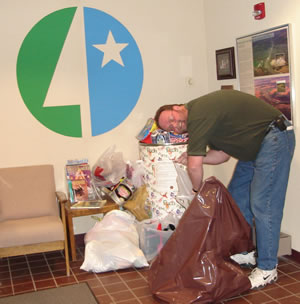 |
|
Paul Bissen, District 6 Toys for Tots coordinator, packs toys from the Rochester office before sending them off in the snowplow. Other District 6 collection sites included the Owatonna and Winona offices. Subarea employees also sent in toys and checks.
Photo by Kristine Hernandez |
Mn/DOT employees raised thousands of dollars for charities, contributed heavily to Toys for Tots and similar programs and donated enough food to fill the bed of a dual-axle snowplow during the holiday season.
Employees in District 3 and the Central Office also gave nearly 100 pints of blood during the holidays.
In Rochester/District 6, employees used a snowplow to deliver hundreds of gifts donated by district staff to the Rochester area Toys for Tots drive. Employees also gave $250 in cash to support the toy drive.
A hospice in Detroit Lakes received more than $1,000 from fund-raising efforts by District 4 employees. This is the 11th year the district has raised funds to support the hospice program. The first donation of $50 was made in 1994.
Two employees from Mankato/District 7 now serving on active duty with the U. S. Army and their families received cash, support and offers of help while they’re on active from their co-workers at Mankato. Tod Becker is a transportation specialist in traffic; Don Baker is a transportation generalist with the Mankato truck station.
A potluck lunch held in their honor included music by district employees Larry Cooper and Mark Scheidel. The event raised nearly $400 for the two families, said Rebecca Arndt, district public affairs coordinator.
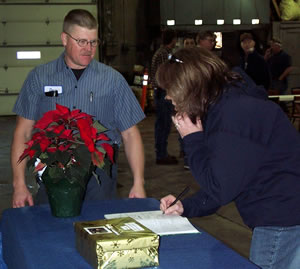 |
Lisa Baker, wife of Don Baker, signs a book of well-wishes while Dave Ivers, heavy equipment mechanic (and also a soldier) visits with her.Photo by Rebecca Arndt
|
Members of AFSCME Local 637 in Bemidji/District 2 donated more than $1,350 to support area food shelves, Toys for Tots and a regional child abuse prevention program.
At Baxter/District 3, employees donated $700 and toys for the Toys for Tots campaign. They also raised $205 from the district’s annual soup-making contest to support a Brainerd area Salvation Army food shelf. Employees at the Baxter office also donated 46 units of blood to the Red Cross.
In the Central Office, a food drive coordinated by Diane Clark, Business and Support Services, generated hundreds of pounds of food for Twin Cities area food shelves. Clark said CO also gave $350 in cash to support food shelf programs.
Staff in the Office of Communications donated cans of soup and other foods to a food shelf as part of its “Souper” holiday party.
The Office of Construction and Innovative Contracting held its annual silent auction of gift items donated by staff members to support Second Harvest, an organization that collects food and cash to support food shelves statewide. The auction and donations raised $925.
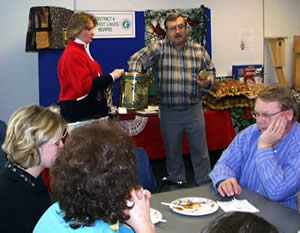 |
Trudy Kordosky (at left) and Bob Kotaska, Detroit Lakes, pull the names of winning chance holders during the district’s holiday fund-raising party for a regional hospice program. Photo by Judy Jacobs |
Sue Stein, auction coordinator, said the Hiway Federal Credit Union matched that amount, raising the total contribution to $1,850.
In addition, credit union staff and members supported food shelves, needy families and the Toys for Tots program, said Marlo Warwick, a marketing specialist.
“I’d like to express my thanks and respect for employees who donated food, gave blood and contributed toys or cash to charities,” said Lt. Gov./Commissioner Carol Molnau.
“This has been a difficult year; many people have been extremely generous to support relief efforts for disasters at home and abroad,” Molnau said. “I am grateful for people who have contributed their time, energy and personal resources to those efforts and to employees who generously supported charitable giving during the holiday season here at home.”
By Craig Wilkins
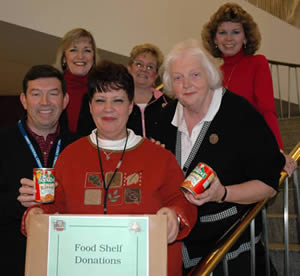 |
Diane Clark, Business and Services (center), led the food drive in Central Office. Other Central Office employees including (from left) Mike Garza, BSS; Cheryl Hunstock, Land Management; Kathy Karels, Electronic Communications; Judy Blitz, District Operations, and Pat Baron, Maintenance, supported the effort. Photo by Colleen Anfang |
|
back

|
 |
Mn/DOT supports drive to boost use of E-85 |
 |
 |
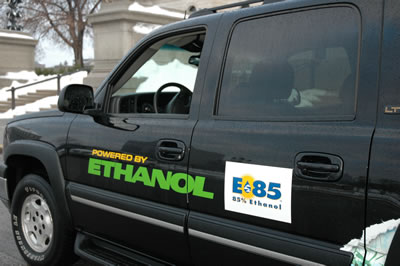 |
|
The E-85 logo shown on the door of this vehicle also will be seen on signs that direct motorists to motels, restaurants and service stations. Photo by Colleen Anfang |
Gov. Tim Pawlenty and Lt. Gov./Commissioner Carol Molnau launched a campaign on the Capitol steps Dec. 23 to increase Minnesotans’ use of the E-85 fuel mix.
They were joined by state Agriculture Commissioner Gene Hugoson and directors of the Minnesota Lung Association and the Minnesota Corn Growers Association. They support increased use of ethanol because it’s renewable, burns cleaner than gasoline and can expand the market for the state’s corn crop.
E-85 is a mixture of 85 percent ethyl alcohol derived from corn and 15 percent gasoline.
Mn/DOT will support the campaign by allowing service stations to add an “E-85” logo on signs that direct motorists to motels, restaurants and service stations. Mn/DOT will also produce news signs advising the proximity of E-85 fueling stations.
The Corn Growers Association will reimburse Mn/DOT for the cost of making and installing the signs.
There are 15 ethanol plants in Minnesota that produce more than 500 million gallons of ethanol every year. Two more plans are under construction. Minnesota ranks fourth nationally producing fuel-grade ethanol after Iowa, Illinois and Nebraska.
Pawlenty said about 120,000 Minnesotans drive flexible fuel vehicles that use E-85. The FFVs can burn either E-85 or gasoline.
Pawlenty, whose official state vehicle is an E-85 Chevy Suburban, said Minnesota has the largest network of E-85 stations in the country. He expects the 200th station to open in February.
"Using homegrown, renewable fuels is good for farmers, rural economic development, national security and the environment," Pawlenty said. “As people consider their New Year's resolutions, I'd encourage them to consider making the switch to renewable fuels."
By Craig Wilkins
|
back

|
 |
Panek named District 6/Owatonna assistant district engineer |
 |
 |
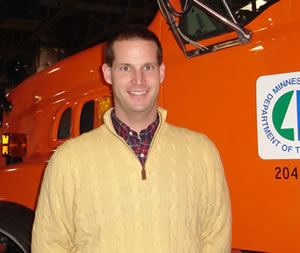 |
Mark Panek was recently appointed to the position of assistant district engineer for West Operations in Owatonna. Support/ Design-Build. Photo by Kristine Hernandez |
Mark Panek was recently appointed to the position of assistant district engineer for West Operations in Owatonna. He succeeds Jeff Vlaminck, who is now District 6’s ADE for Program Support/Design-Build.
Panek’s responsibilities include maintenance operations, construction, vehicle fleet, shop and buildings for the west side of District 6. In this position, he will be part of the Operations Managers Group and Construction Managers Group.
Panek previously had served in the position as part of a development exchange program.
“Mark's previous experience, interpersonal skills, problem-solving skills and management skills make him an excellent person to fill this position,” said Nelrae Succio, District 6 engineer.
Panek is a graduate of the University of Minnesota with a bachelor’s degree in civil engineering. He has more than 15 years experience at Mn/DOT, beginning as a student worker in the Bridge Office. He was hired in 1991 as a graduate engineer on rotation with the Metro District. His other Metro District positions include project engineer, resident engineer in the Eden Prairie office and project manager for the Interstate 494/I-169 interchange project.
“When I initially applied for the mobility assignment, I looked at this as a good way to expand my knowledge of the maintenance operations of Mn/DOT,” said Panek. “I also enjoy the people that I work with and am glad that I have the opportunity to continue to build on those relationships.”
By Kristine Hernandez, District 6 public affairs coordinator
|
back

|
 |
District 6 names Moates as its planning director |
 |
 |
 |
|
Chris Moates, formerly a planner with the Metropolitan Council in St. Paul, was appointed as the planning director for District 6/Rochester. Photo by Kristine Hernandez |
Chris Moates, formerly a planner with the Metropolitan Council in St. Paul, was appointed as the planning director for District 6/Rochester. He succeeds Dale Maul, who resigned earlier this year.
Moates’ new duties include managing project reviews, transit programs, recreational trail development and the district’s work with the regional area transportation partnerships.
Moates previously served with Rochester/District 6 as planner from November 2001 to January 2005.
“It’s great to be back—again,” said Moates. “I look forward to the challenge of improving upon our development review process, recreational trail planning and our communications with the area’s cities and counties by utilizing our talented staff.
“The planning department will also be improving upon our existing level of mapping capabilities regarding our geographic information systems, which will enhance our ability to communicate graphically for both internal and external clients.”
His previous experience includes planning positions with Dakota County, Dakota Area Resources and Transportation for Seniors and the city of Inver Grove Heights.
Moates holds a bachelor’s degree in geography from the University of Minnesota and a master of arts degree in Urban and Regional Studies from Minnesota State University-Mankato. He is a member of the American Planning Association.
By Kristine Hernandez, District 6 public affairs coordinator
|
back

|
 |
Henkel to direct Metro’s Office of Program Management and Passenger Rail |
 |
 |
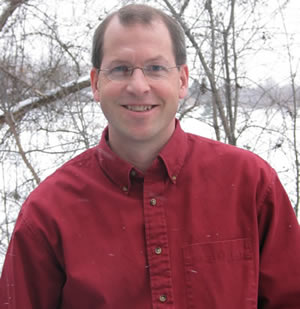 |
Tim Henkel is the new director of Metro District’s Office of Program Management and Passenger Rail. Photo by Kent Barnard |
Tim Henkel will serve as the director of Metro District’s Office of Program Management and Passenger Rail, Pat Hughes, Metro district engineer, announced Dec. 19. As such, Henkel will direct several activities, including:
- Metro District annual construction program/budget
- Department, district and Twin Cities multi-agency plans, programs and research
- Passenger rail planning, including the Northstar Corridor Rail Project
- Metro District Leadership Team
A 21-year Mn/DOT employee, Henkel’s experience includes working in the areas of Transportation Planning, Preliminary Design, Final Design, and Program Management. In 2000 he became director of Metro District Program Management.
Henkel also has played a leadership role in a variety of regional, district, department and national committees and initiatives.
Prior to joining Mn/DOT, Henkel worked in the private sector and in local government. He holds a bachelor of science degree in Geography from Bemidji State University and is a graduate of the Dunwoody College of Technology – Civil Engineering and Land Surveying.
|
back

|
 |
Funeral services pending for Office of Materials’ Rolf Stimac |
 |
 |
Funeral services are pending for Rolf Stimac, a senior transportation generalist with the Office of Materials in Maplewood.
Stimac died suddenly on Dec. 31. He was 50.
Stimac began working in June 2005 with the Materials Testing Section in its concrete and metals testing lab. Previously, Stimac worked in the Office of Land Management. He joined Mn/DOT in 1997.
Daniel Squires, Stimac’s supervisor at Maplewood, said Stimac was reliable and dedicated and was always upbeat.
“He was a very positive person,” Squires said. “He will be missed.”
Stimac was single and had no children. He lived in Maplewood. Stimac was a native of Hibbing, Minn. His survivors include a brother and nieces and nephews.
|
back

|
 |
"Listening through an Accent" topic of diversity forums |
 |
 |
Diversity forums that will be offered on Jan. 25 and Feb. 1 will help employees who interact with international speakers learn to better understand different accents.
During this forum, participants will learn to listen to different cultural voices to decode the articulation, intonation and grammar patterns of speakers from Latin America, Russia, Somalia and Southeast Asia.
The sessions are part of a series of diversity forums that will be offered this year. The first in the series, Breaking Ice, was offered in September. Future forums will focus on issues involving generations, gender and race.
The forums are open to all employees. The Jan. 25 forum will be held in the Metro area and the Feb. 1 forum will be held in Duluth. Future forums will be held at other locations throughout the state.
For information about how to sign up for the Jan. 25 or Feb. 1 forum, click here: Forum announcement and enrollment.
|
back

|
 |
New machine control project receives award for innovative use of technology |
 |
 |
Machine control, a three-dimensional computer model that guides earth-moving equipment, received the 2005 Minnesota Government Information Technology Recognition award from Government Training Services at the December Information Technology Conference.
Dick Stehr, director, Engineering Services Division, accepted the award for Mn/DOT and said that the construction industry is ready to use machine control.
“Machine control allows the contractor to do its work more efficiently and with greater precision,” Stehr said. “It could mean substantial cost savings for the contractor and also to Mn/DOT in lower bid pricing.”
Contractors used machine control on several Mn/DOT projects during the 2005 construction season, including resurfacing of Hwy 64 near Akeley in District 2, reconstruction on Hwy 371 near Baxter in District 3, and interchange construction on Hwy 169 in Belle Plaine, Metro District.
“With machine control, information is sent from GPS satellite transmitters to three-dimensional computer models that tell heavy equipment operators how much earth to remove or correct level of aggregates to apply,” said Lou Barrett, transportation program supervisor.
“On some projects, the machine controls the earth moving via computer while the operator simply drives down the roadbed,” she said.
Barrett added that this technology minimizes survey stakeout and helps ensure a smooth driving surface when the project is complete.
For more information about machine control, go to Mn/DOT’s Computer Aided Engineering Services Web site at http://www.dot.state.mn.us/tecsup/caes/machine.html.
By Donna Lindberg
|
back

|
 |
Commissioner answers employee questions |
 |
 |
On Dec. 8, Lt. Gov./Commissioner Carol Molnau talked live to Mn/DOT employees in the Central Office cafeteria and via streaming video on desktop computers and in video conference rooms statewide.
Employees were encouraged to ask Molnau questions following her talk or submit them in advance via GroupWise. Answers to the most common questions are now posted on the commissioner’s iHUB site at http://ihub.dot.state.mn.us/commissioner/.
|
back

|
 |
|
 |



